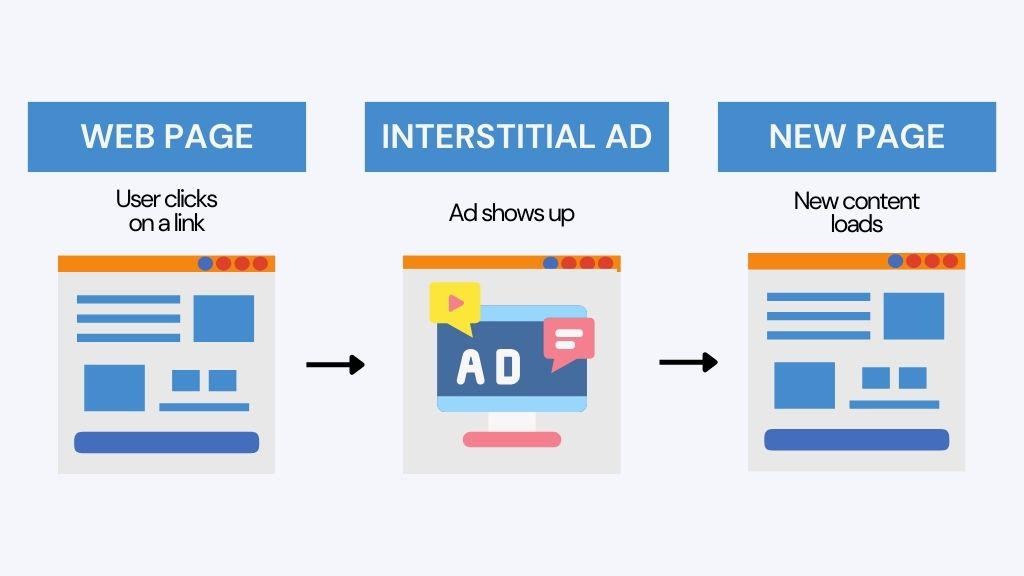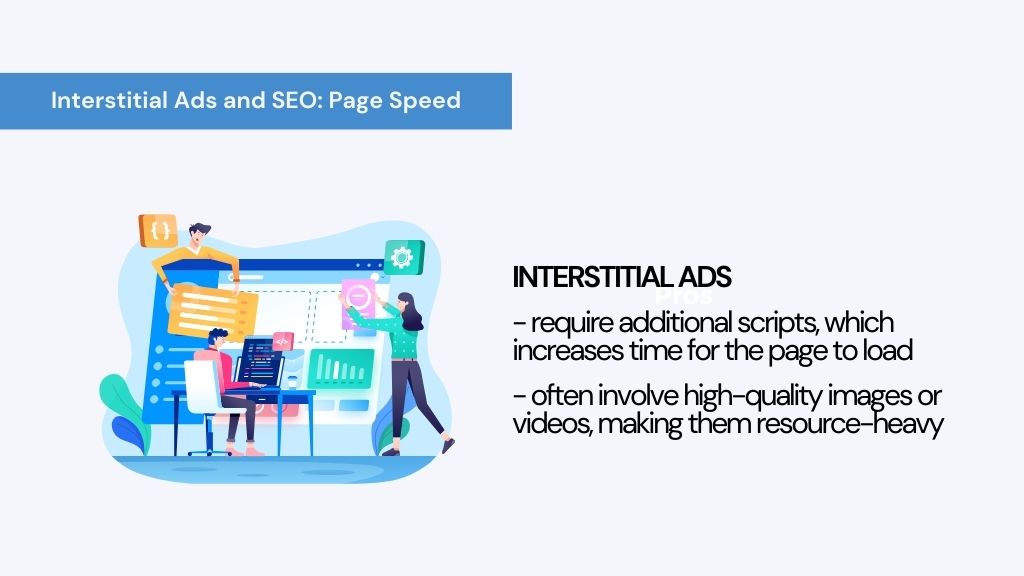How Interstitial Ads Affect SEO

Interstitial ads are those full-screen ads that pop up on a website, often covering the entire page until you close them. While these ads can be effective for marketing, they can also impact your website’s SEO. In this blog post, we will explore how interstitial ads affect SEO and provide expert recommendations for using them effectively without hurting your site’s performance.
In this article:
- What Are Interstitial Ads?
- Advantages and Disadvantages of Interstitial Ads
- How Interstitial Ads Affect SEO
- 6 Best Practices for Using Interstitial Ads
- Alternatives to Interstitial Ads
- Monitoring the Impact of Interstitial Ads
What Are Interstitial Ads?
Interstitial ads are interactive, full-screen advertisements that appear before or after a webpage’s content is loaded. These ads require the user to either close or engage with them before they can access the main content.
Examples.
- Welcome Screens: Show up when a user first visits the website.
- Exit Ads: Displayed when a user is about to leave the site.
- Ads Between Content: Appear between different pieces of content, such as between articles or pages within an app.
They’re not to be confused with pop-up ads, which appear suddenly and cover part of the webpage. Interstitial ads take up the entire screen, but they can also be pop-up in nature.
Advantages and Disadvantages of Interstitial Ads

Advantages
- High Visibility: Since they cover the entire screen, users are more likely to notice them.
- Better Engagement: These ads often require user interaction, increasing engagement rates.
- Effective for Conversions: Interstitial ads can be great for capturing leads or encouraging users to take specific actions, like signing up for newsletters.
Disadvantages
- Interruptive: Can be annoying and disrupt the user experience.
- High Bounce Rates: Users may leave the site immediately if they find the ads intrusive.
- Impact on SEO: Improper use of interstitial ads can negatively affect your site’s search engine rankings.
How Interstitial Ads Affect SEO

User Experience (UX)
User experience is a significant factor in SEO. Search engines, especially Google, prioritize websites that provide a good user experience. Interstitial ads can disrupt the user experience in the following ways:
- Annoyance Factor: Users may get frustrated if they have to close an ad to access the content.
- Navigation Issues: Full-screen ads can make it harder for users to navigate the site.
- Content Accessibility: Users may struggle to find the content they are looking for if interstitial ads cover it.

Google’s Mobile Interstitial Penalty
In January 2017, Google introduced a penalty for websites that use intrusive interstitials on mobile devices. This penalty aims to improve mobile user experience by discouraging the use of ads that block content. Here’s how it works:
- Penalty Criteria: The penalty applies to interstitials that cover the main content and are difficult to dismiss.
- Impact: Sites that use intrusive interstitials may see a drop in their search engine rankings, particularly in mobile search results.
Page Load Speed
Page load speed is another crucial factor in SEO. Interstitial ads can slow down your website in the following ways:
- Additional Scripts: Loading interstitial ads requires additional scripts, which can increase the time it takes for the page to load.
- Resource Heavy: Full-screen ads often involve high-quality images or videos, further slowing down the load time.
Bounce Rates
Bounce rate refers to the percentage of visitors who leave your site after viewing only one page. High bounce rates can signal to search engines that your site isn’t providing a good user experience. Interstitial ads can contribute to higher bounce rates because:
- Disruption: Users might leave the site if they find the ads too intrusive.
- Annoyance: Frequent pop-ups can annoy users, prompting them to exit the site immediately.
6 Best Practices for Using Interstitial Ads

1. Use Sparingly
Limit the use of interstitial ads to avoid overwhelming your visitors. Reserve them for critical messages or high-impact promotions.
2. Provide Clear Close Options
Gabe Garcia, founder and CEO of Pierre Park, a premium dog treat brand, emphasizes the importance ensuring that users can easily close the interstitial ad. “Provide clear and easy-to-find options to skip or close the ad to maintain a positive user experience and maximize effectiveness,” he writes. A clearly visible close button can reduce frustration in your web visitors and encourage them to continue exploring your site.
3. Avoid on Mobile Devices
Given Google’s penalty for intrusive mobile interstitials, it’s best to avoid using these ads on mobile sites. Instead, opt for less disruptive formats like banners.
4. Optimize Load Speed
Ensure that interstitial ads don’t significantly slow down your page load times. Use optimized images and efficient coding practices.
5. Use Timed Ads
Consider using timed interstitials that appear after the user has spent a certain amount of time on the page. This can reduce the initial frustration and improve engagement.
6. Display Relevant Content
Make sure the interstitial ad content is relevant to your site’s audience. Irrelevant ads can lead to higher bounce rates and a negative user experience.
Alternatives to Interstitial Ads
If you’re concerned about the impact of interstitial ads on your SEO, consider using these less intrusive alternatives:

1. Inline Ads
Inline ads are placed within the content of your page. They don’t cover the screen and are less likely to disrupt the user experience.
2. Sticky Banners
Sticky banners remain at the top or bottom of the page as the user scrolls. They are visible but not as intrusive as interstitial ads.
3. Slide-In Ads
Slide-in ads appear from the side of the screen, catching the user’s attention without covering the main content.
4. Exit-Intent Popups
Exit-intent popups appear when the user is about to leave the site. This can capture their attention at a critical moment without disrupting their browsing experience.
Monitoring the Impact of Interstitial Ads
Use Analytics Tools
Use tools like Google Analytics to monitor the impact of interstitial ads on your site’s performance. Track metrics such as:
- Bounce Rate: Measure any changes in bounce rate after implementing interstitial ads.
- Page Load Time: Monitor how the ads affect your page load times.
- User Engagement: Track user interactions with the ads and the overall site.
Conduct A/B Testing
A/B testing involves comparing two versions of a webpage to see which performs better. Use A/B testing to experiment with different ad formats and placements to find the least intrusive yet effective option.
Gather User Feedback
Collect feedback from your site’s visitors to understand their experience with interstitial ads. This can provide valuable insights into how these ads affect user satisfaction and engagement.
Use Interstitial Ads Wisely
Interstitial ads can be a double-edged sword. While they can drive engagement and conversions, they can also harm your website’s SEO if not used correctly. To ensure that your interstitial ads don’t negatively impact your site’s performance, use them sparingly, provide clear close options, avoid using them on mobile devices, and monitor their impact through analytics and user feedback.
Using interstitial ads wisely can help your outreach campaigns perform better. Additionally, leveraging Link Genius can make your off-page SEO efforts soar. Secure valuable backlink opportunities to boost your site’s authority and visibility with Link Genius today.
